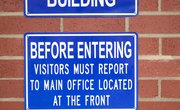The Centers for Disease Control & Prevention identified more than 800,000 reported cases of school violence in 2010. These statistics cover everything from bullying to threats to physical fights and show that school safety is a serious issue. However, violence is less likely in private high schools due to their ability to manage or avoid the main risk factors.
Discipline
If a student has been violent before, he is likely to be violent again. However, it's difficult for public schools to permanently remove these students. In most states, expulsion involves warnings, multiple hearings, appeals and a final judgment by the board of education. This process is reserved for the most dangerous behavior. Students can commit dozens of acts of minor violence before a school is able permanently remove them from the environment. In private schools, students can be expelled with less bureaucracy. Most have a code of conduct that serves as a contract between school and student. If a student violates that contract, he can be expelled. Therefore, private schools can remove potentially violent students at the earliest sign of trouble.
Adult Supervision
Private schools have the distinct advantage of smaller classes, which subsequently leads to more teachers or staff per student. In fact, on average, the ratio of teacher to student in private high schools is 20 percent lower than in public. This means teachers in private schools have fewer students to watch and more chances to interact with students. This increased level of adult supervision generally equals less bullying, fighting and other types of violence.
Poverty
Another leading factor in school violence is poverty. Not all students who are struggling financially are violent; however, poverty can be a stressor for high school students because it causes many other problems. For example, students who live in poverty may have more volatile home lives. They may be exhausted from caring for other siblings or from juggling a part-time job to pay for family expenses. These tensions can build up over time and erupt into violence. Private schools, with tuition fees that range from a few hundred to tens of thousands of dollars, attract a wealthier population and eliminate this source of tension.
Academic Achievement
When a student consistently performs at an academic level that is much lower than his intelligence, this is often a warning sign of other problems. In fact, it's one of the main risk factors for violent behavior. Private high school students, on the other hand, routinely have higher levels of academic achievement than their public school counterparts. They have higher standardized test scores, higher graduation rates and higher overall grade point averages, in spite of a more challenging curriculum. This academic success tends to translate into equally high levels of satisfaction with their schools and peers -- a main deterrent of violent behavior.
Related Articles
References
Writer Bio
Kimberly Yates has been both writing and teaching since 1997. She has been published in a variety of magazines, including "The Alfred Hitchcock Mystery Magazine" and "Woman's World." She has a Bachelor's degree in English and a Masters in English education.











